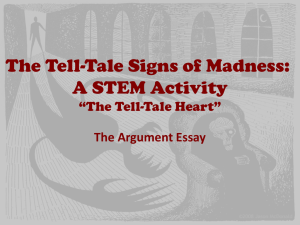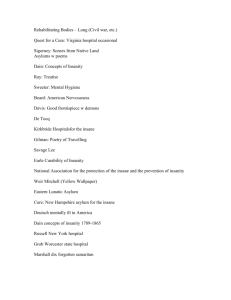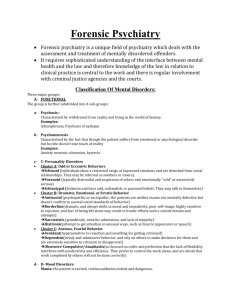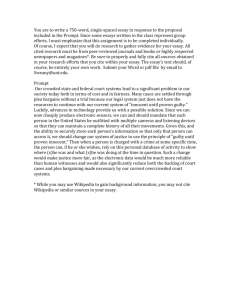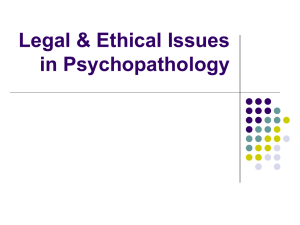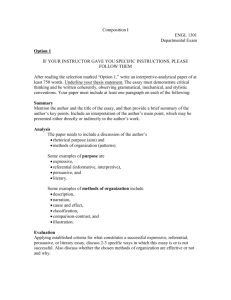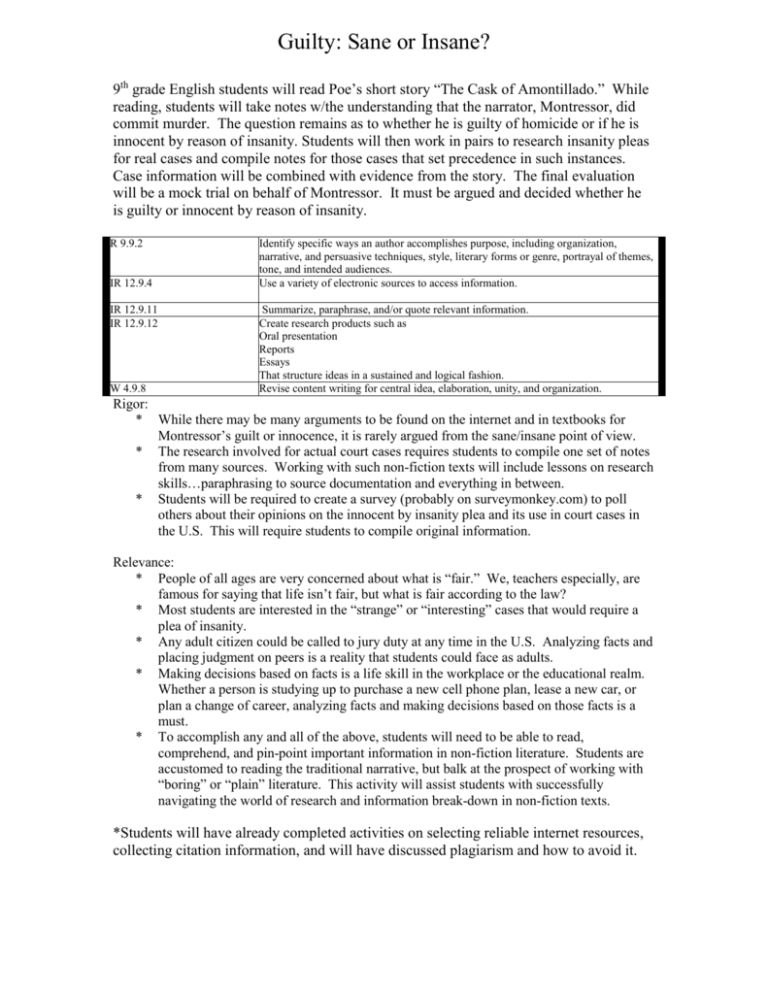
Guilty: Sane or Insane?
9th grade English students will read Poe’s short story “The Cask of Amontillado.” While
reading, students will take notes w/the understanding that the narrator, Montressor, did
commit murder. The question remains as to whether he is guilty of homicide or if he is
innocent by reason of insanity. Students will then work in pairs to research insanity pleas
for real cases and compile notes for those cases that set precedence in such instances.
Case information will be combined with evidence from the story. The final evaluation
will be a mock trial on behalf of Montressor. It must be argued and decided whether he
is guilty or innocent by reason of insanity.
R 9.9.2
IR 12.9.4
IR 12.9.11
IR 12.9.12
W 4.9.8
Identify specific ways an author accomplishes purpose, including organization,
narrative, and persuasive techniques, style, literary forms or genre, portrayal of themes,
tone, and intended audiences.
Use a variety of electronic sources to access information.
Summarize, paraphrase, and/or quote relevant information.
Create research products such as
Oral presentation
Reports
Essays
That structure ideas in a sustained and logical fashion.
Revise content writing for central idea, elaboration, unity, and organization.
Rigor:
* While there may be many arguments to be found on the internet and in textbooks for
Montressor’s guilt or innocence, it is rarely argued from the sane/insane point of view.
* The research involved for actual court cases requires students to compile one set of notes
from many sources. Working with such non-fiction texts will include lessons on research
skills…paraphrasing to source documentation and everything in between.
* Students will be required to create a survey (probably on surveymonkey.com) to poll
others about their opinions on the innocent by insanity plea and its use in court cases in
the U.S. This will require students to compile original information.
Relevance:
* People of all ages are very concerned about what is “fair.” We, teachers especially, are
famous for saying that life isn’t fair, but what is fair according to the law?
* Most students are interested in the “strange” or “interesting” cases that would require a
plea of insanity.
* Any adult citizen could be called to jury duty at any time in the U.S. Analyzing facts and
placing judgment on peers is a reality that students could face as adults.
* Making decisions based on facts is a life skill in the workplace or the educational realm.
Whether a person is studying up to purchase a new cell phone plan, lease a new car, or
plan a change of career, analyzing facts and making decisions based on those facts is a
must.
* To accomplish any and all of the above, students will need to be able to read,
comprehend, and pin-point important information in non-fiction literature. Students are
accustomed to reading the traditional narrative, but balk at the prospect of working with
“boring” or “plain” literature. This activity will assist students with successfully
navigating the world of research and information break-down in non-fiction texts.
*Students will have already completed activities on selecting reliable internet resources,
collecting citation information, and will have discussed plagiarism and how to avoid it.
Day 1:
Read along with “The Cask of Amontillado” text as a class while listening to the reader
on the CD (provided w/textbook). On provided worksheet, students will take notes about
specific instances in the story where it could be argued that Montressor is sane or insane
for performing certain actions.
Classes will discuss notes collected during reading and compare opinions of sanity or
insanity of specific actions on the part of the main character, Montressor.
*Stess to students that the question is not whether or not a crime was committed, but
whether Montressor is guilty or innocent by reason of insanity.
Day 2:
Students will take notes on, identify, and practice using persuasive writing strategies.
Hand out copies of “Persuasive Strategy Definitions” note sheet. At the website
http://www.readwritethink.org/lesson_images/lesson56/persuasive_strategies.pps , you
will find a PowerPoint presentation to show on the overhead projector. Have students fill
in “example” column on note handout as PowerPoint is discussed. *From the local Times
Record newspaper, I read examples of each strategy from random articles and
advertisements.
PERSUASIVE STRATEGY DEFINITIONS
Example
Definition
Claim – your main point
Big Names – experts and important
people that support your side of
the argument
Logos – using logic, numbers, facts, and data
to support your argument
Pathos – appealing to your audience’s emotions
Ethos – making yourself seem
trustworthy and believable
Kairos - building a sense of urgency
for your cause
Research – using studies and
information to make your argument
seem more convincing; you can use
words, graphs, tables, illustrations
Homework-Day2: Students will complete the “Persuasion Is All Around Us” handout,
also from the Read, Write, Think website on persuasive writing.
http://www.readwritethink.org/lessons/lesson_view.asp?id=56
Day 3:
Review homework handout (persuasive strategies used in print and/or television).
Practice persuasive strategies by providing writing prompts. In groups of three, have
students respond to the prompt of their choice in a paragraph, using one of the persuasive
writing strategies discussed in the notes from day two. *Everyone should be practicing on
the same strategy at the same time. It will be possible to practice at least two in one class
period. *
Allow students to confer w/their group members in order to complete the practice
activities. As students create practice drafts, the teacher should monitor group progress
and complete the “Observations and Notes” sheet for each class. This will allow the
teacher to track progress and address mistakes as students practice using the strategies.
After practicing each strategy, the teacher should review observation notes with the class
and redirect mistakes as necessary.
Group members:
___________________________________________________________________
OBSERVATIONS
AND
NOTES
Check the strategies that group members are using to build their argument. Jot down their
reasons in the Notes section to use as examples later.
_____ Claim – Students state what they are trying to convince the audience of
_____ Authorities or “Big Names” – Students cite well-known authorities or experts to
get the audience to believe their argument
_____ Logos – Students use facts, data, statistics, or numbers to support their argument
_____ Pathos – Students appeal to the audience’s emotions
_____ Ethos – Students try to gain the audience’s trust and show their credibility and
honesty
_____ Kairos – Students try to build a sense of urgency and convince the audience that
they must act now
_____ Research – Students cite research (websites, articles, experts) to build their
arguments; they show graphs, tables, or charts to help persuade
Notes
Copyright 2006 IRA/NCTE. All rights reserved.
ReadWriteThink.org materials may be reproduced for educational purposes.
[Locker Searches/Personal Searches] The principal at your school has instituted random locker
and backpack/book bag searches to check for guns, knives, and other weapons. Anyone caught
with these weapons will be immediately suspended. The principal argues that the random
searches will not only guard against illegal weapons at school but will also will help students feel
safer. What is your position on this issue? Write a letter to the editor of a local newspaper stating
your position and supporting it with three convincing reasons.
[Online Schools] The state department of education has provided funding for an experimental
online school. All the classes will take place on the Internet, using email, online chat, and the
World Wide Web. The students taking classes at this new online school will never meet each
other face-to-face. They will only interact online with each other and with their teachers. The
state is hoping this program will provide fairer educational access to students in outlying, rural
areas. Opponents of the program argue that because of their lack of interaction with other students
in a traditional classroom, the students who attend this online school will not develop the social
skills that should be a component of their education. What is your position on this issue? Write a
letter to the editor of your local newspaper stating your position on this issue and supporting it
with three convincing reasons.
[Computers in the Classroom] As part of a new technology initiative, your local school district
is increasing the number of computers in every school. The district plan provides for two
computers in every classroom. Teachers at your school are lobbying instead to place all the
computers together, creating two computer-based classrooms so that all students in a class can
work at the computers together, rather than only one or two students at a time. The district is
worried about the additional cost of creating and maintaining these special classrooms and is
concerned about how access to the classrooms can be provided fairly and efficiently. What is
your position on this issue? Write a letter to the editor of your local newspaper stating your point
of view and supporting it with three convincing reasons.
[Bilingual Education] As part of a proposed educational initiative in your state, local school
districts are responsible for providing required courses in both English language and Spanish
language in order to increase the success of their programs. Because your state has a large
population of Spanish speakers, the state education department believes that teaching these
students in their first language will help them learn better and more quickly. Because of the
limited budget, however, the local school board is concerned that they may not be able to provide
the additional teachers or training needed for this program. They fear that they will lose state
funding and accreditation even though 90% of the district's students pass their achievement tests
on the first try. What is your position on this issue? Write a letter to the editor of your local
newspaper stating your point of view and supporting it with three convincing reasons.
[Grade Scale Change] One of the biology teachers at your school has decided to change from a
ten-point grade scale (100 to 90 is an A, 89 to 80 is a B, etc.) to a seven-point grade scale (100 to
93 is an A, 92 to 85 is a B, etc.). The teacher is trying to encourage students to put more effort
into their classes by raising the requirements. What is your position on this issue? Write a letter to
the editor of your local newspaper stating your position and supporting it with convincing
reasons.
[Litter] A litter problem has developed on your school's campus. Students are throwing trash on
the ground, leaving empty soda cans and bottles outside on benches, and dropping napkins and
other trash on the cafeteria floor rather than carrying them to the trash can. Your principal has
asked students to take more care, but the litter problem persists. The principal has reacted by
cancelling all after-school activities until the problem is taken care of. What is your position on
this issue? Write a letter to the editor of your local newspaper stating your position and
supporting it with convincing reasons.
[Curfew] The mayor of your city is trying to decide if a 9:00p.m. curfew on weekdays for
children under the age of 16 is needed. What do you think? Write a persuasive essay to the mayor
[Mr. Baker] to convince him to enact or not to enact, the curfew. Give at least three reasons to
support your position.
Day 4/5:
Library research for persuasive essay, students working in pairs:
In the library, review “Cask of Amontillado” notes with students. Provide list of reliable
websites for researching the insanity plea in court cases.
http://www.washingtonpost.com/wp-srv/local/longterm/aron/qa227.htm#TOP
The Insanity Defense: A Closer Look
By John P. Martin
Washingtonpost.com Staff Writer
Friday, February 27, 1998
http://www.psychiatrictimes.com/display/article/10168/54196
April 1, 2002
Psychiatric Times. Vol. 19 No. 4
Does the Insanity Defense Have a Legitimate Role?
James F. Hooper, M.D., F.A.P.A., and Alix M. McLearen, M.S.
http://www.pbs.org/wgbh/pages/frontline/shows/crime/trial/history.html
PBS: Frontline
http://www.law.cornell.edu/background/insane/insanity.html
An important distinction: "Not guilty by reason of insanity" and
"diminished capacity"
http://www.healthyminds.org/insanitydefense.cfm
*American Psychiatric Association*
Questions and Answers on
Using “Insanity” as a Legal Defense
How can a person who admits committing a crime be found "not guilty by reason
of insanity?"
http://law.jrank.org/pages/7672/Insanity-Defense.html
Insanity Defense - History, Colin Ferguson, Is There A Need For
The Insanity Defense?, Consequences, Defendants' Rights
*Students will also be searching school-sponsored databases such as EBSCO.
Students will be researching to address the following questions:
1. What is the legal definition of insanity?
2. How does the insanity plea change a court case?
3. What is the history of the insanity plea in court cases?
4. How often do defendants plead legally insane?
5. How successful, historically, is the insanity plea?
6. Why do defendants or their defense team choose the insanity plea?
*Reviewing your notes on Montressor’s behavior, do you believe his case qualifies for a
legal insanity defense? Why or why not? Use the answers to the above questions to help
support your position.
Day 6-9:
http://teacher.scholastic.com/activities/writing/conduct.asp?topic=Women
Beginning with the “prewriting” (“make your case” tab) at the Scholastic web site,
students will begin to formulate their persuasive essay, arguing either for or against the
insanity plea for Montressor’s case.
Students will be lead through the persuasive writing process on the overhead projector
and will work in groups to provide needed support. Each student must submit their own
paper.
*See Persuasive Writing Rubric below.
Individual grades will be taken on the following pieces of the essay in progress:
-Outline (student choice of format)
-Thesis statement
-Introductory paragraph
-Body paragraphs
-Concluding paragraph
-Works cited page
*Approximately two-three days will be provided between each step. It is at teacher
discretion to add or subtract days necessary to complete each item.
*Students will work in class with teacher and peer feedback to guide progress toward
final copy of essay.
*Upon completion of final copy, students are provided two days in class to type their
essay if desired. My students have access to two desktop computers, eleven Palms, and
five AlphaSmarts.
COMPONENT
Persuasive Writing Scoring Guide
6
5
4
3
2
Takes a clear
position and
supports it
consistently
with wellchosen
reasons and/or
examples;
may use
persuasive
strategy to
convey an
argument.
Is focused and
well
organized,
with effective
use of
transitions.
Takes a clear
position and
supports it
with relevant
reasons and/or
examples
through much
of the essay.
Takes a clear
position and
supports it
with some
relevant
reasons and/or
examples;
there is some
development
of the essay.
Is well
organized, but
may lack
some
transitions.
Is generally
organized, but
has few or no
transitions
among
sections.
Sentence Fluency
and Word Choice
Consistently
exhibits
variety in
sentence
structure and
word choice.
Conventions
Errors in
grammar,
spelling, and
punctuation
are few and do
not interfere
with
understanding.
Exhibits some
variety in
sentence
structure and
uses good
word choice;
occasionally,
words may be
used
inaccurately.
Errors in
grammar,
spelling, and
punctuation
do not
interfere with
understanding.
Most
sentences are
well
constructed
but have
similar
structure;
word choice
lacks variety
or flair.
More frequent
errors in
grammar,
spelling, and
punctuation,
but they do
not interfere
with
understanding.
Focus
Organization
1
Takes a
position and
provides
uneven
support; may
lack
development
in parts or be
repetitive OR
essay is no
more than a
well-written
beginning.
Is organized
in parts of the
essay; other
parts are
disjointed
and/or lack
transitions.
Sentence
structure may
be simple and
unvaried;
word choice is
mostly
accurate.
Takes a
position, but
essay is
underdeveloped.
Attempts to take
a position
(addresses topic),
but position is
very unclear OR
takes a position,
but provides
minimal or no
support; may
only paraphrase
the prompt.
Is disorganized
or unfocused in
much of the
essay OR is
clear, but too
brief.
Exhibits little or
no apparent
organization.
Sentences lack
formal
structure; word
choice may
often be
inaccurate.
Sentences run-on
and appear
incomplete or
rambling; word
choice may be
inaccurate in
much or the
entire essay.
Errors in
grammar,
spelling, and
punctuation
sometimes
interfere with
understanding.
Errors in
grammar,
spelling, and
punctuation
interfere with
understanding
in much of the
essay.
Errors in
grammar,
spelling, and
punctuation
prevent
reader from
fully
understanding
essay.
Day 10:
Students will use their research findings and the arguments presented in their papers to
put Montressor on trial. A judge is to be appointed, a jury selected, defense and
prosecution will be prepped with student research findings, and Montressor himself will
make an appearance. Based on research evidence and the defendant’s behaviors, the jury
must decide whether Montressor is guilty of homicide, or innocent by reason of insanity.
Take a Poll!
As a part of your research for the insanity plea report, you are required to survey at least
thirty (30) or your friends, family, and/or acquaintances about their opinion of the
insanity plea in criminal cases. You are to create three questions in reference to this
topic, to be cleared by your teacher prior to actually performing the survey. Once your
questions have been approved, you will ask each participant to answer all questions on
your survey. When you have at least thirty participants, you will chart the answers to
your questions. The results should be used to support your argument, either for or against
the insanity plea, in the case of Montressor.
Guilty: Sane or Insane?
(A researched report)
*Reviewing your notes on Montressor’s behavior in “The Cask of Amontillado,” do you
believe his case qualifies for a legal insanity defense? Why or why not? Use the answers
to the provided questions to help support your position.
1. What is the legal definition of insanity?
2. How does the insanity plea change a court case?
3. What is the history of the insanity plea in court cases?
4. How often do defendants plead legally insane?
5. How successful, historically, is the insanity plea?
6. Why do defendants or their defense team choose the insanity plea?
In addition to the school-sponsored data bases available to you in the media center, the
following web sites have been pre-approved for your use: (You must have at least two sources)
http://www.washingtonpost.com/wp-srv/local/longterm/aron/qa227.htm#TOP
“The Insanity Defense: A Closer Look”
By John P. Martin
http://www.psychiatrictimes.com/display/article/10168/54196
Psychiatric Times
“Does the Insanity Defense Have a Legitimate Role?”
James F. Hooper, M.D., F.A.P.A., and Alix M. McLearen, M.S.
http://www.pbs.org/wgbh/pages/frontline/shows/crime/trial/history.html
PBS: Frontline
http://www.law.cornell.edu/background/insane/insanity.html
An important distinction: "Not guilty by reason of insanity" and "diminished capacity"
http://www.healthyminds.org/insanitydefense.cfm
*American Psychiatric Association*
“Questions and Answers on Using ‘Insanity’ as a Legal Defense”
http://law.jrank.org/pages/7672/Insanity-Defense.html
You are to determine whether you believe Montressor’s actions, as outlined in class
notes, are due to crafty human planning, or simply a lack of mental capacity (insane).
Once you have decided which way you plan to argue, use the databases and websites to
find information that supports your ideas. Individual behaviors identified in your notes
should be used in conjunction with the information you locate in your research.
*You must provide source citation information for every single resource you use!
In the media center databases, source information is provided for you in every article.
For the World Wide Web sites, refer to owl.english.purdue.edu/owl/resource. This is
an online guide to in-text (parenthetical) citation and crediting sources on the works cited
page.
Essay Checklist:
Are you for or against the insanity plea for Montressor’s crime?
You must have at least two sources to support your argument.
All sources must have citation information both in the essay (in-text) and on the
works cited page (follows the essay on separate paper).
Your essay must be at least one page typed, two pages hand-written.
If you choose to type, follow these guidelines:
12-point font
Times New Roman font only!
Black ink only!
*You will be researching with a partner, but each of you will be responsible for your own
notes, work, and essay. You must do your own work to produce the final copy!
Example of final copy:
“Guilty: Sane or Insane?”
In Edgar Allen Poe’s tale of horror, The Cask of Amontillado, the lead character,
Montressor, carried out a foolproof plan to inflict revenge upon his “friend,” Fortunato.
Whatever may have occurred between these two gentlemen, homicide was committed by
Montressor. Although Montressor was guilty beyond a shadow of a doubt, the question
remains about the stability of his mental state at the time. Would it have been possible
for Montressor to have claimed the insanity plea as a means of defense, if he had been
caught in his crime? I think not.
According to the American Psychiatric Association, legal insanity, in reference to
a criminal trial, does not mean that a person did not actually commit the crime in
question. “’Not guilty’…means that when the person committed the crime, he or she
could not tell right from wrong or could not control his or her behavior because of severe
mental defect or illness” (2003, para. 1). I will prove that Montressor was aware of the
wrongful nature of his actions, based upon his premeditated plan.
Montressor designed his entire plot of treachery on the fact that he knew
Fortunato had a single weak point…Amontillado, the rare fine wine. He used this
weakness of Fortunato’s to devise a specific time, place, and method of dispatch of his
associate.
The fine details of Montressor’s obsession were revealed throughout the plot of
Poe’s classic tale. Montressor planned to meet Fortunado on the very occasion he was
certain his friend would be inebriated and compliant…carnival. After the initial meeting,
Montressor lured him down into the family catacombs on the pretense of tasting the
beloved Amontillado. These actions were curiously unobserved by the manor staff,
whom Montressor counted on being away for the evening. As these men traveled further
and further underground in pursuit of the fictional Amontillado, Montressor continually
offered Fortunato other drinks, causing him to fall deeper into his drunken stupor.
As the men continued to the proposed location of the Amontillado, Montressor
made a jest in reference to his own trowel, the tool of the mason, the bricklayer.
Fortunato did not understand, but soon would. Finally having arrived at the end of the
catacombs, Fortunato was led to the wall, chained around his waist, and prevented from
escape. Amazingly, or not so, Montressor revealed his pre-placed stack of bricks, hidden
from view by a stack of old bones. All of these odd coincidences lead to a simple
conclusion – Fortunato’s premeditated murder.
“Some states also allow defendants to argue that that they understood their
behavior was criminal but were unable to control it. This is sometimes called the
‘irresistible impulse’ defense (Martin, para. 5). Montressor clearly cannot be held to the
standard that he had some sort of “uncontrollable impulse.” The elaborate detail of his
plan plainly reveals evidence that must have taken months, maybe more, to perfect.
While it could be argued that Poe’s heinous character, Montressor, was nothing
more than a mad man, I have provided proof that he was simply a murderer, in his right
mind, who could have easily been tried and found guilty in a court of law. As they say, it
was Montressor, in the catacombs, with the trowel.
Works Cited
Martin, John P. The Washington Post.com. http://www.washingtonpost.com/wpsrv/local/longterm/aron/qa227.htm#TOP. The Washington Post. February 27, 1998.
February 4, 2009.
“Questions and Answers on Using ‘Insanity’ as a Legal Defense.”
http://www.healthyminds.org/insanitydefense.cfm. American Psychiatric Association.
September, 2003. February 4, 2009.

